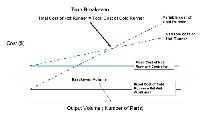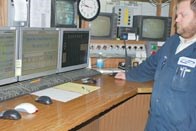Making Plating Lean
Automation boosts process flexibility for mix of parts
Grilles, bumpers, plastic parts, steel parts—none of that matters on the two chromium electroplating plating lines operated by Meridian Automotive Systems (Ionia, MI). The company, a Tier 1 supplier to Ford Motor Co. and other automotive OEMs, employs a PC-based system to automate its plating operations and integrate the plating lines with a plant-wide production and inventory control system.
"We run plastic and steel parts side by side on two plating lines," explains Meridian plant manager Keith Sawyer.
The plating operations are located in Meridian's main plant in Ionia, which encompasses 750,000 ft2 of production area and employs more than 500 people in production and management. The company also operates a 90,000 ft2 paint facility in Ionia that employs 42 people in both electrocoat and top coat/clear coat painting, as well as an E-coat plant in Grand Rapids, MI.
The main plant houses four automated transfer stamping lines for steel bumpers; three buff houses for buffing of steel components prior to plating; 10 plastic injection molding machines for production of fascias, grilles, step plates and other components; and robotic and manual welding capability. Flexible assembly operations enable Meridian to build front and rear bumper systems for the F-150 pickup in the order in which they will be used by Ford's assembly plants in Dearborn and Kansas City.
"We build the F-150 bumper systems in ILVS--in-line vehicle sequencing," Sawyer explains. "That means we ship systems in the order Ford is going to build the vehicles. We produce full bumper system assemblies, including valences, fog lamps, license plate holders, and other components, for Dearborn, and partial build-ups for Kansas City."
Scheduled to build 580,000 F-150 bumper systems this year despite current economic conditions, Meridian also produces front and rear bumpers for the Ford Ranger pickup and Econoline van. Other components manufactured in Ionia include chrome-plated plastic grilles for a variety of Ford trucks and SUVs, as well as for the just-launched and much-anticipated 2010 Ford Taurus. Taurus grilles will be produced in two finish variations, bright chrome and a darker gray finish.
Plating Process
Meridian's chromium plating process begins when parts are loaded on flight bars at one end of the twin plastic and steel lines, which are located side by side. Plastic parts are polycarbonate, ABS or a PC-ABS blend.
An automated crane picks up a flight bar and loads it into a shuttle bound for the correct line. For plastic components, the process begins with pre-etch and etch stages. "PC-ABS blend parts go through the pre-etch stage because they're a bit harder than straight polycarbonate," explains plating manager Tom Witzel. "The pre-etch runs at 150°, the etch stage at 140°. We use a chromic acid etch, which we think is easier to control and more environmentally friendly than a solvent-based etch."
Etched parts travel through multiple counterflow rinses, a neutralizer stage, more rinses and an accelerator stage before application of a layer of electroless nickel. "Some places use copper, but we chose electroless nickel because again we felt it was easier to control," Witzel says. "After that it's a copper strike, acid copper, and then multiple nickel layers before the chrome is applied."
Finishing of steel parts begins with buffing in one of Meridian's automated buff houses, which contain 23–25 buffing heads, from coarse to polish. Plating of steel parts is similar to the plastic process, but omits the etching and activation stages needed for plastic components.
Plating process time is 3.5 hr for plastic parts and 2 hr for steel, with a capacity of 15 flight bars/hr on the plastic line and 28 flight bars/hr on the steel plating side. Chemistries are supplied by Atotech USA Inc. (Rock Hill, SC), and the chromium layer is hexavalent.
"We've looked at trivalent, but we are sticking with the hex chrome for the time being," Witzel says.
Completed parts go through a blow-off station to remove any water droplets, which can cause spotting. They're then unloaded onto a conveyor and taken for inspection and packaging.
Quality is assured in an in-house lab with a spectrometer, metallography equipment for preparing samples for coating thickness measurement, and salt-spray and cyclic environmental test chambers. The lab also handles analysis of plating process chemistries and wastewater.
Control & Automation
Meridian began plating steel components at the Ionia plant nearly 20 years ago, on a line featuring a state-of-the-art system that controlled crane movement, monitored all process variables and allowed dynamic scheduling for plating of up to 16 different components. But a combination of the limitations of that system, plus a desire to begin production of plated plastic components, drove the company to seek an updated solution in 2006.
"We wanted to replace the old system for a number of reasons," Sawyer says. "The old system was obsolete. Parts availability and service got to be problems, and we couldn't modify the system ourselves.
"At the same time, we saw an opportunity to begin producing plastic parts. We looked at the grilles we were buying, the cost and quality, and decided we could compete," he continues. "So the decision was made to go to plastic, but along with that we needed a control system that could handle both the plastic and steel plating lines and give us the capability to do modifications and simulations in-house."
The company's in-house control engineers evaluated possible vendors based on two key selection factors: the ability to maintain and modify the system in-house, and the ability of the system to provide real-time control of the steel and plastic plating operations. Meridian eventually selected a system from ASC Process Systems (Sylmar, CA).
"ASC met our requirements, and did it in our time frame," Sawyer says. "Not only did we have to have programming developed for the plastic line, but it had to integrate with the steel line. And, we couldn't miss a step on our steel line while we did all this." The plating-on-plastics line and new control system were up and running in July 2007—only seven months from the start of the project.
In the current system, a central control room containing multiple computer and TV monitors is manned by a single operator who oversees plating operations on both lines. "The system gives operators a real-time picture of what's happening on both lines," Witzel says. "We can see the position of all flight bars, what's loading into which tank—everything. The system also monitors all process temperature, amperages, and other parameters and gives us alarms if there's a problem."
The ASC system is integrated with Meridian's plant-wide production control system, and also allows the company to store plating process data. "Now we have traceability on all parts that move through the plating line," Witzel says, "so if a part in the field fails for some reason, we can track it back to the date, time and tanks where it was plated."
Chemical additions are also completely controlled and automated by the system—a change from manual additions of process chemicals that Witzel says has improved quality and process control. "In the past, we did manual additions," Witzel says. "The new system includes an auto-add chemical feed system that runs based on amp-hours. So depending on the number of flight bars moving through the tanks, it automatically adds the correct amounts of the right chemicals. Eliminating manual additions has enabled us to tighten process parameters much more."
Additions are made from directly from drums next to the line. Each drum has its own pump and control panel, and a line running into a feed tank. "It's safer for employees, who don't have to make manual additions," Sawyer says. "And, the ability to control chemistries more tightly and have a more stable process is resulting in cost reductions and allowing our plating personnel to focus on preventive maintenance."
Related Content
Ultrafiltration Membranes, Filter Elements for Improved Industrial Water Reuse
Ultrafiltration membranes help with water reuse in a variety of applications.
Read MoreNASF/AESF Foundation Research Project #120: Electrochemical Destruction of Perfluorooctanesulfonate in Electroplating Wastewaters - April 2022-March 2023
This NASF-AESF Foundation research project report covers project work from April 2022 to March 2023 at the University of Illinois at Chicago. The overall objective of this work is to utilize a cost-effective reactive electrochemical membrane (REM) for the removal of PFAS from synthetic electroplating wastewater. Initial results for the oxidation of PFOA with three different catalysts are discussed.
Read MoreNASF/AESF Foundation Research Project #121: Development of a Sustainability Metrics System and a Technical Solution Method for Sustainable Metal Finishing - 15th Quarterly Report
This NASF-AESF Foundation research project report covers the twelfth quarter of project work (October-December 2023) at Wayne State University in Detroit. In this period, our main effort focused on the development of a set of Digital Twins (DTs) using the Physics-Informed Neural Network (PINN) technology with application on parts rinsing simulation.
Read MoreNASF/AESF Foundation Research Project #122: Electrochemical Approaches to Treatment of PFAS in Plating Wastewater - 10th Quarterly Report
The NASF-AESF Foundation Research Board selected a project addressing the problem of PFAS and related chemicals in plating wastewater streams. This report covers the 10th quarter of work (April-June 2023). Here, we examine the effect of surface fluorination of Ti4O7 anodes on PFAS degradation performance in terms of energy performance as well as formation of chlorate and perchlorate when chloride is present in the solution. The full paper on this work can be accessed and printed at short.pfonline.com/NASF24Feb2.
Read MoreRead Next
Episode 45: An Interview with Chandler Mancuso, MacDermid Envio Solutions
Chandler Mancuso, technical director with MacDermid Envio discusses updating your wastewater treatment system and implementing materials recycling solutions to increase efficiencies, control costs and reduce environmental impact.
Read MoreEducation Bringing Cleaning to Machining
Debuting new speakers and cleaning technology content during this half-day workshop co-located with IMTS 2024.
Read MoreDelivering Increased Benefits to Greenhouse Films
Baystar's Borstar technology is helping customers deliver better, more reliable production methods to greenhouse agriculture.
Read More














.jpg;maxWidth=300;quality=90)









